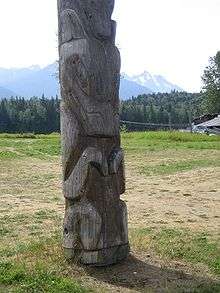Kitwanga

Kitwanga /ˈkɪtwəŋɡə/ or Gitwangak or Gitwangax ("people of the place of rabbits" in the Gitxsan language) is located where the Kitwanga River runs into the Skeena River in British Columbia. A long-standing village before contact, the village is within Gitwangak Indian Reserve No. 1.[1]
There is recreational salmon fishing (chinook, coho, pink, sockeye and steelhead).The community is governed by a local band office. As of the current census the population of Kitwanga is approximately 480[2] and is primarily a small town made up of patriarchal families like the Ranahans and the Spooners.
National Historic Site of Canada

The totem poles of Gitwangak village are a National Historic Site of Canada, as is also Kitwanga Fort.
The Gitxsan Nation is made up of:
- Kitwanga (Gitwangak)
- Kispiox (Anspayax)
- Glen Vowell (Sik i dak)
- Old Hazelton (Gitanmaax)
- Gitsegukla, also spelled Kitseguecla or Kitsegukla
- Cedarvale (Meanskaniist or Minskinish,).
- 'Ksan (living museum/historical village)
Coordinates: 55°06′N 128°04′W / 55.100°N 128.067°W
Directions
North of Kitwanga stands Meziadin Junction (156), Stewart (221), and Dease Lake (488). West of Kitwanga is Terrace (91), Kitimat (149), and Prince Rupert (235). And East of Kitwanga is New Hazelton (48), Moricetown (81), Smithers (112), Telkwa (129), and Prince George (482).
See also
- Kitwanga Fort National Historic Site
- Kitwanga Mountain Provincial Park
- Kitwanga railway station
- Kispiox
- Hazelton
- Tsimshian
- Nisga'a
References
- ↑ BCGNIS entry "Gitwangak Indian Reserve 1"
- ↑ "Community Futures 16/37 | Community Profiles | Kitwanga & Area". www.1637cfdc.bc.ca. Retrieved 2015-12-24.